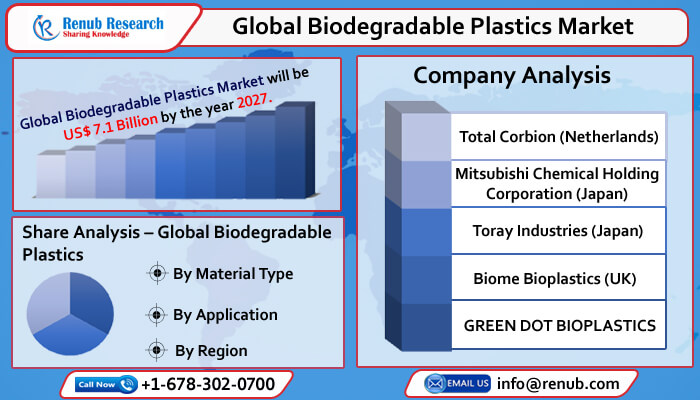Global Biodegradable Plastics Market to Reach USD 7.1 Billion by 2027, Driven by Awareness of Conventional Plastic's Harmful Impact on the Environment
17 Jan, 2022
According to Renub Research report, tittled “Biodegradable Plastics Market Size, Global Forecast 2021-2027, Industry Trends, Impact of COVID-19, Opportunity Company Analysis” the Biodegradable Plastics Market was USD 4.3 Billion in 2021. In the wake of plastic pollution increasing worldwide, biodegradable plastics are one of the fastest-growing segments within the global plastics industry. Nevertheless, Bioplastic is a sustainable material derived from renewable feedstocks, and is an alternative to petroleum-based plastics. It can reduce 30-70% of carbon dioxide emissions. It represents 42% reduction of carbon footprints. The production of bioplastic requires 65% less energy than conventional petroleum plastic.
How Covid-19 Helped the Biodegradable Plastics Industry to Grow
The global biodegradable plastics industry witnessed a positive impact owing to the novel coronavirus lockdown globally. The number of medical items like sanitizer bottles, face masks, and gloves increased, creating huge plastic waste. This aspect has made a massive opportunity for biodegradable plastics to produce personal protective equipment and sanitizer bottles. Prominent industry leaders adopt different growth strategies like a geographical expansion to increase their capacity and productivity.
Global Biodegradable plastics Resin Market Drivers:
Worldwide, the increasing environmental concerns about plastic usage (as plastics contain toxic pollutants that harm animals, plants, and people) are propelling the use of biodegradable plastic alternatives. Floating plastic waste that survives thousands of years in water can perform as a transportation device for invasive species that disrupt habitats. This factor above is contributing to the growth of the market.

Thus, the stringent regulations by various governments and federal agencies to reduce plastic waste and promote biodegradable plastics usage in packaging are expanding the demand of this market. The laws related to green packaging are rising. As a result, various FMCG companies are required to adopt biodegradable packaging to yield with the standards, which is propelling the blossoming of this market.
The use of Starch blends is stimulating the biodegradable plastics industry to blossom.
Based on material type, the biodegradable plastics market is divided into Polybutylene adipate Terephthalate (PBAT), Polybutylene Succinate (PBS), Polylactic Acid (PLA), Polyhydroxyalkanoate (PHA), and Starch Blends. Starch blends appeared as the global leader in revenue share in the biodegradable plastic market. This is accounted to its demand in flexible packaging and the agricultural sector. Starch blends are widely used to reduce the carbon footprint of conventional resins, thus enhancing demand growth.
Furthermore, the adoption of Polylactic Acid (PLA) bioplastic has increased tremendously across packaging and consumer goods applications due to the avant technical properties and functionalities. The demand for Polylactic Acid (PLA) bioplastics has gained tremendous traction in various plastic applications due to the favorable legislations implemented by many governments around the globe.
Moreover, there is an increased demand for bioplastic packaging for wrapping organic food and premium and branded products with specific needs. A combination of recycling components from conventional plastics, such as PET with bioplastics (bio-based PET), provides high-performance processing of bioplastics packaging. Biodegradable food packaging, certified as industrially compostable, was the first successfully commercialized bioplastic product.
North America is one the Biggest Consumer in Biodegradable Plastics
Regionally, the North American region is predicted to be one of the biggest consumers of biodegradable plastics, which is majorly credited to the extensive presence of packaged food manufacturers in Canada & the United States. Being environmentally conscious and increasing the spending power of the consumers is one of the significant drivers increasing the demand of the market in the region.
Further, the transition to a low-carbon and circular economy, more vital policy support for the economy, and raised consumer awareness for sustainable products and packaging are compelling the expansion of the market in Europe. The use of biodegradable plastics, primarily in European countries, also increases in other niche components, such as drug delivery systematical implants.
Key Players:
The global biodegradable plastic market is highly fragmented, as the international participants are driving toward inventing new technologies to manufacture pliable packaging material from different readily available natural resources. The players' substantial investments in research and development to create innovative products generate high competition. The key players are Total Corbion (Netherlands), Mitsubishi Chemical Holding Corporation (Japan), Toray Industries (Japan), Biome Bioplastics (UK), and Green Dot Bioplastics.
Market Summary:
- Material Type – Renub Research Report covers by Material Type in the 6 viewpoints (Polybutylene adipate Terephthalate (PBAT), Polybutylene Succinate (PBS), Polylactic Acid (PLA), Polyhydroxyalkanoate (PHA), Starch Blends and Others)
- Applications – Our Report covers by Application in the 4 viewpoints (Packaging, Agriculture, Consumer Goods and Others)
- Regions – This Report covers Market breakup by 5 Regions (North America, Europe, Asia-Pacific’s, Latin America and Middle East & Africa)
- All the key players have been shielded from 3 Viewpoints (Overview, Recent Development, and Revenue Analysis) Total Corbion (Netherlands), Mitsubishi Chemical Holding Corporation (Japan), Toray Industries (Japan), Biome Bioplastics (UK) and Green Dot Bioplastics
Reach out to us
Call us on
USA: +1-678-302-0700
INDIA: +91-120-421-9822
Drop us an email at
info@renub.com